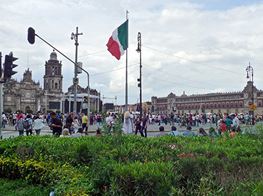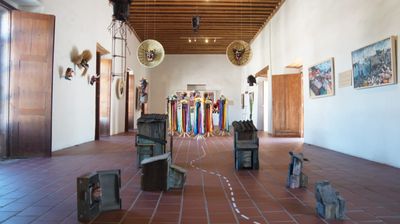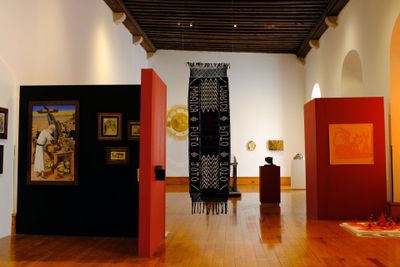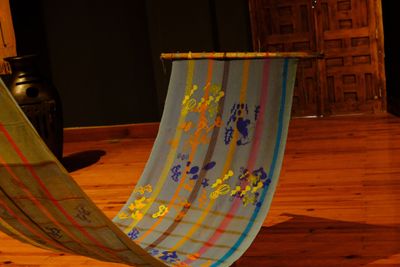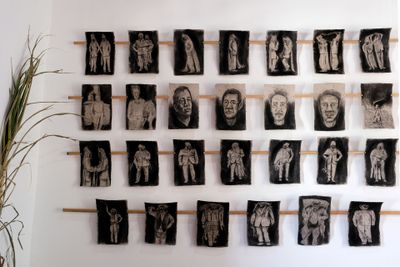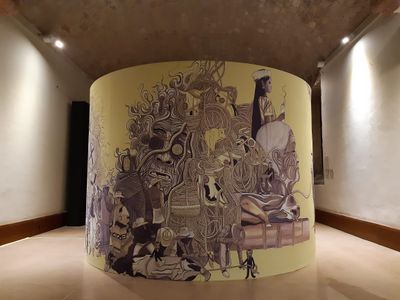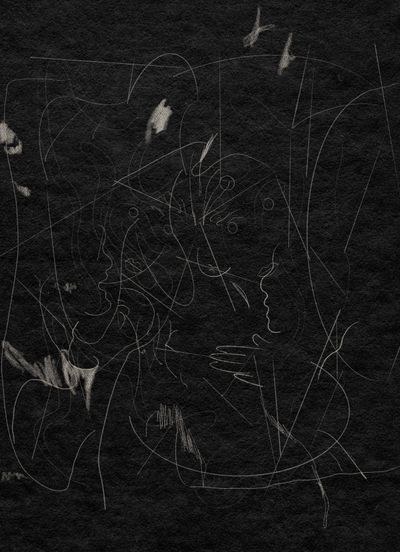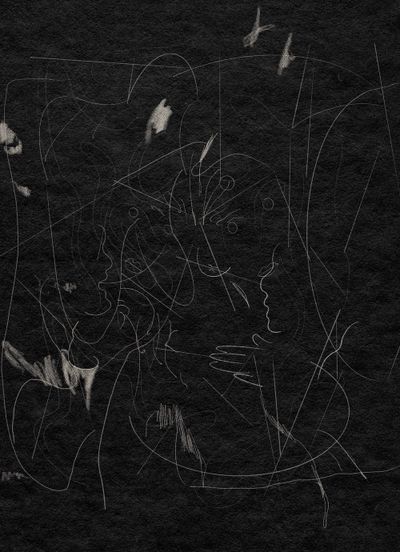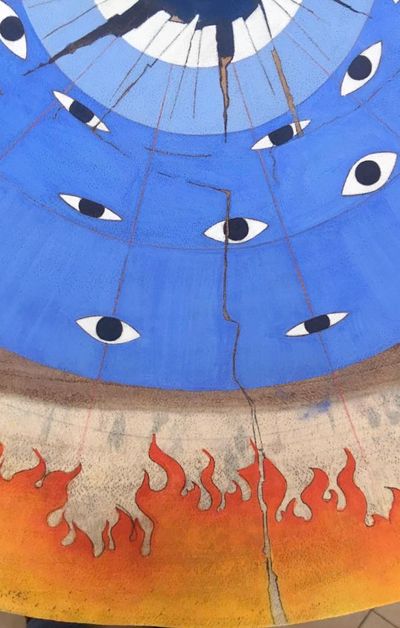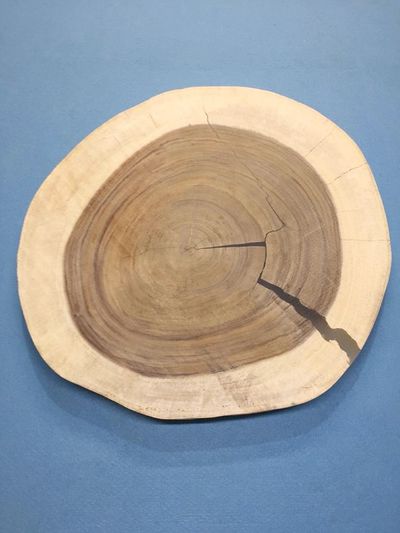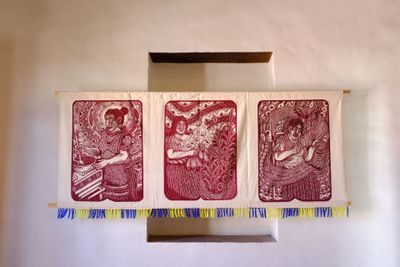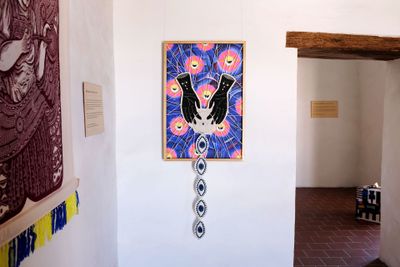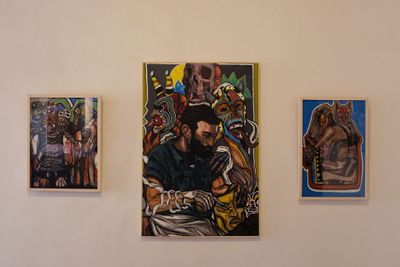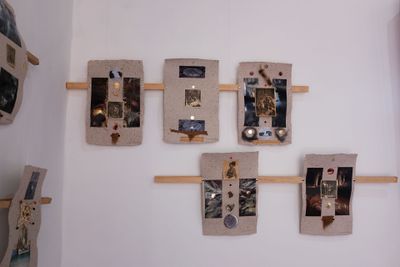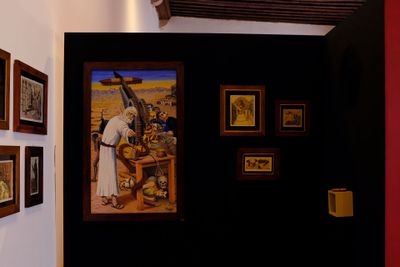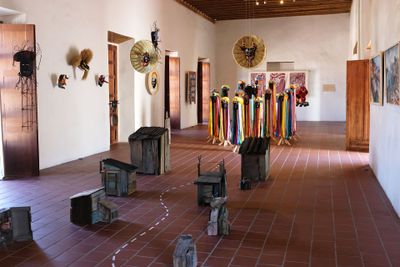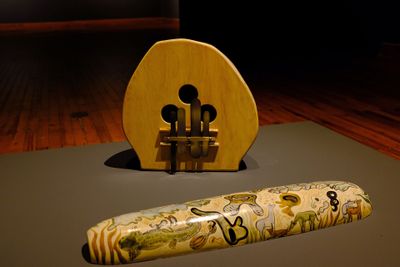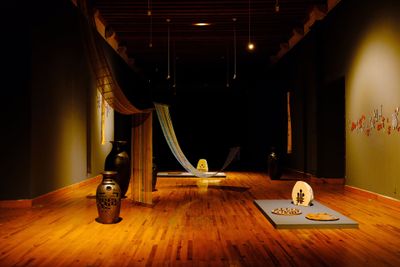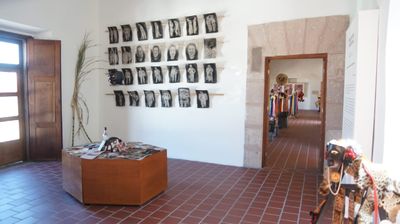Mexico's FEMSA Biennial Finds Ways To Decentre
From left to right: Esteban King and Daniel Garza Usabiaga. Courtesy FEMSA Biennial.

From left to right: Esteban King and Daniel Garza Usabiaga. Courtesy FEMSA Biennial.
In a world in crisis, how do biennial institutions change, transform, and adapt? In 2020, the question feels especially urgent, particularly when it comes to the way a biennial can connect with audiences in meaningful ways.
In the case of the 14th FEMSA Biennial in Mexico, which opened in February 2020 and runs through February 2021, the biennial transformed into a space for process-based artistic practices, experiential learning, and meaningful artistic engagement with local audiences. Titled Inestimable Azar, or Inestimable Chance, the event takes place across Morelia and Pátzcuaro, two cities in the state of Michoacán, and proposes a conversation that embraces the country's rich cultural heritage.
Throughout the year-long programming, commissioned artistic projects are focusing on establishing networks between sister cities, giving new meaning and potency to the notion of the local.
Besides the planned exhibitions, highly involved and active public and education programming has turned the biennial into a somewhat itinerant, independent art school; a place outside of the typical academic setting for diverse publics to engage in the learning and appreciation of art. For this, the biennial team, headed by artistic director Daniel Garza Usabiaga, is putting together weekly workshops, talks, and artistic programmes, partnering with invited artists, art students, and a range of art institutions.
Twenty-six artists have been invited to create in situ projects, workshops, and learning initiatives that, while not following one single theme or position, either establish a dialogue with local cultures, or propose experimental educational practices in which the artistic and the pedagogical are truly intermixed. Invited artists include Carlos Amorales, Juan Francisco Maldonado, Patricia Belli, Gabriel Rico, and Livia Corona Benjamin, among many others.
While all public programmes, talks, and workshops have migrated to FEMSA Biennial's online platform, the biennial exhibitions are on view throughout five main venues, including Centro Cultural Clavijero, Museo de Arte Contemporáneo Alfredo Zalce, Casa Taller Alfredo Zalce, Museo de Estado in the city of Morelia, and the Centro Cultural Antiguo Colegio Jesuita in Pátzcuaro.
Biennials are always changing and adapting to our fast-moving circumstances. Underscoring the roles that culture, patrimony, and the networks of art play in our world today, it is important to consider how artistic practices can move away, as artistic director Daniel Garza Usabiaga stresses, from market forces and into places for learning through more affective pedagogies.
With this in mind, I invited Daniel Garza Usabiaga and FEMSA Biennial's curator of public and education programmes, Esteban King, to discuss the approach that Inestimable Azar has taken to engage local audiences while also adapting to the Covid-19 pandemic.
SGFEMSA Biennial was founded in 1992 to attend to Mexico's rapidly growing art scene. Since the 12th edition in 2016, the biennial has adopted new research methodologies and public engagement modalities, becoming an alternative institutional model to art events nationwide. Daniel can you tell us how the biennial differs this year?
DGUTwo years ago, the biennial proposed new approaches to decentring that would take the event away from the usual spaces in Monterrey, Mexico City, and Guadalajara.
On the one hand, the new itinerant format seeks to resist the harmful centripetal forces that push art to be exhibited exclusively in the nation's centres, and only in traditional art institutions. On the other hand, it helps us recognise the different ways of understanding contemporary artistic practices throughout Mexico that still remain somewhat isolated and disconnected from practices happening in the capital, which upholds dynamics more in dialogue with the global market.
In that sense, this year's public programme is bringing into discussion the historiographic task of re-reading of our local cultural patrimony. Due to its rich artistic history, the state of Michoacán presents interesting examples of where the local intersects with the national and the global.
The most illustrative case is the series of murals in Morelia and Pátzcuaro during the 1930s and 40s, executed by important international artists such as Grace and Marion Greenwood, Juan O'Gorman, Reuben Kadish, and Philip Guston. These modern art projects allow us to think of a new conception of art history that can be written far from the centres, while still addressing national and international issues.
SGBuilding on that approach, how did the curatorial vision or scope change?
DGUWe increased the number of commissioned artists to 26, with their works to be made locally responding to the cities and communities we engage with. To further decentralise, and because it would be pretentious to think that we could get to know local artists in a short period of time, we turned to local partners who range in age, experience, and background.
Apart from this, five local curators are hosting five different group exhibitions that showcase the work and trajectories of artists originally from and/or residing in Morelia, Pátzcuaro, and other neighbouring cities.
Partnering curators include Patzcuaro-based Erandi Ávalos, who has organised the show Mystical Vision. Thoughts on Fear, Death, and Love (2 November 2020–15 February 2021) and Cherán-based Francisco Huaroco, who curated the exhibit K'eri K'uinchikua: Transformation of Wealth in the Social Fabric (16 November 2020–15 February 2021), both of which are now open to the public at Centro Cultural Clavijero in Morelia.
Due to its rich artistic history, the state of Michoacán presents interesting examples where the local intersects with the national and the global.
Diego Rodríguez curated Counter-Aesthetics of the Popular: Subaltern Histories at Museo de Arte Contemporáneo Alfredo Zalce (30 November 2020–15 February 2021); Jesús Jiménez curated Inestimable Chance: A Dream of Stone and Sand at Casa Taller Alfredo Zalce (30 November 2020–15 February 2021); and Ángel Pahuamba did Realities and Destinies, now on view at Museo del Estado in Morelia (2 November 2020–15 February 2021).
SGAs Daniel has pointed out, the curatorial programme has also expanded. Esteban, can you tell us more about how the artistic commissions engage the cultural patrimony of Michoacán and Patzcuaro?
EKAll participating artists have been invited to produce a work of art that is in dialogue with Michoacán's local patrimony. Jalisco-born artist Leo Marz, for example, is basing his commission on the larger format of post-revolutionary mural painting in Mexico, drawing on the work of important figures like Diego Rivera, Juan O'Gorman, Philip Guston, and Reuben Kadish.
The large-scale paintings are also evocative of the work of 19th-century artist Gerardo Murillo, also known as Dr. Atl. Known for his stunning portrayals of Mexico's vistas, Dr. Atl portrayed the changing scenery of the imposing Paricutín volcano in Michoacán.
Marz's project questions how isolation during the pandemic has transformed our contemporary view of nature through technological mediation, underscoring new digital temporalities. His work Humo Ajeno (Foreign Smoke) (2020) is now on display at the Centro Cultural Clavijero in Morelia (2 November 2020–February 2021).
On the other hand, Mexican artist Circe Irasema explores the traditional technique of wood plate decoration called peribana, which has historically been done by Purépecha Indigenous artists. She observes the technical and stylistic changes that this artistic tradition has undergone over the centuries, with influences of Arabic painterly techniques and European iconographies.
The artist researches both the object's history and trajectory, while infusing it with new contemporary perspectives, which she developed in an eight-piece final artwork titled Los Agüeros (2020). More than simply inquiring into traditional techniques, the piece is an opportunity to delve into subjects affecting the Purépecha communities in Michoacán due to massive deforestation and ecological destruction, paramilitary violence, and endangered cultural traditions.
The intertwined relationship between these issues and the creation of the wooden plates is also illustrated in a stop-motion animation that the artist will feature alongside her peribanas. The work is on view at the Centro Cultural Clavijero.
SGBeyond decentring, which is so important to reaching local audiences across the country, the biennial format itself has also moved away from what the biennial team has called an 'exhibition-centric' framework towards a more integrated pedagogical programme. Can you tell us how this is happening?
DGUOne of the most relevant proposals that curator Willy Kautz made for the 13th FEMSA Biennial, We Have Never Been Contemporary, was the inclusion of a pedagogical and public programme so that the biennial did not focus exclusively on an exhibition.
The programme was then largely directed by Brazilian artist and renowned arts educator Mônica Hoff, who focused on affective pedagogies. For this year's edition, we kept these programmes but made some modifications.
In our first visits to Michoacán, local agents told us about their interest in better integrating an educational platform within the exhibition. However, while we wanted to meet this demand, we did not want to focus solely on the issue of mediation, which is why Esteban King thought of a more comprehensive proposal.
Just as it did for everyone else, the Covid-19 crisis, which we are still facing, modified the plans we had for the biennial.
Besides a number of professional development workshops, classes, and talks, this educational programme includes what we called the 'Curatorial Anti-Manual', which collects a variety of experiences from the professionals that we invited, who are working in areas of management, museography, archival, fundraising, curatorship, mediation, criticism and writing, editorial work, pedagogical models, and self-managed initiatives.
These experiences represent a series of alternatives for thinking about exhibition-making from a broad perspective, not limited to standard exhibition formats. The Anti-Manual, therefore, corresponds to our intention and that of the participants to think about methods for writing, presentation, and mediation at large. This document will be published digitally after the closure of the biennial in the early months of 2021.
The wonderful educators, artists, and scholars who join us for the pedagogical programme and who will be contributing to the Curatorial Anti-Manual include Ana Bidart, Giacomo Castagnola, Catalina Lozano, Sandra Sánchez, Verónica Gerber Bicecci, and Alfonso Santiago, among others.
SGSince the workshops and teaching spaces are still a fundamental part in the realisation of the event during these difficult months of lockdown, can you discuss the particular projects that took place? How did they adapt?
EKJust as it did for everyone else, the Covid-19 crisis, which we are still facing, modified the plans we had for the biennial. At the beginning of the year, we hosted talks, workshops, and conferences that brought together a large number of people from Morelia and Pátzcuaro, as well as from different areas of Michoacán.
The health contingency made us take the public and pedagogical programmes to a virtual modality. The biennial, from the beginning, was proposed as a meeting point to exchange experiences and knowledge.
Being separated as a result of the pandemic drastically modified our capacity to connect with each other on a more personal level. Isolation, ironically, made the need for this exchange more poignant, but it did not prepare us to mediate through an entirely digital framework.
In that sense, we are still faced with the question of how to make virtual space a site for affective learning and exchange. Months have passed, and like most people doing similar things, we are still learning on the go about how to make online programmes meaningful for all participants.
As part of the educational programme, for instance, Nicaraguan artist and educator Patricia Belli planned a collaboration with young local artists. However, due to the contingency, she could not visit or work as closely in the planning of the project.
Instead, over the course of the last several months, the artist collected anxiety dreams from a variety of people in Nicaragua and Mexico and made them available on the online archive.
The dreams were then used by these ten young creators from Michoacán, who, guided by Belli, developed projects that sought to understand the sanitary crisis from the perspective of these dreams. The works are currently on view at the Museo de Arte Contemporáneo Alfredo Zalce en Morelia.
Also invited was the Costa Rican collective La Ruidosa Oficina, who have a long trajectory of integrating art and education. They imparted a virtual workshop called 'Mediating Distance: Archives and Affects', in which they addressed topics of site-specificity and community activism (11 November 2020).
The biennial, from the beginning, was proposed as a meeting point to exchange experiences and knowledge.
In fact, La Ruidosa Oficina is also an active member of the Empathetic Pedagogies Network, a group of transnational cultural promoters in Latin America dedicated to exploring the relationship between art and education towards social justice. These artists' participation thus contributes to the biennial's efforts to explore new approaches to public engagement that problematises exhibition sites beyond that of display, while bringing young art people into transnational networks of collective organising.
SGHow have the efforts to connect and build strong communities in Morelia and Pátzcuaro been impacted by Covid-19-related circumstances? What new challenges have you seen while imparting the educational programme?
EKThe digitisation of the biennial has had many challenges, but it also opened up new possibilities.
On the one hand, although programmes continue to target local audiences in Michoacán, the virtual modality has allowed people from all over Mexico and Latin America to join in the conversation. For this reason, although the pedagogical programme was originally designed for smaller working groups, we have adapted so that a more significant number of people can participate.
On these lines, artist Ana Bidart held a mediation workshop in the summer, for which participants made drawings and models that they shared through a digital working platform. Around the same time, the artists Nuria Montiel and María Cerdá Acebrón also gave an arts and crafts workshop.
While imparted online, Nuria and María made physical kits that were shipped and distributed among the participants so that they could have the materials at home. Some of the outcomes of this workshop are now part of the commissioned project that Nuria Montiel is presenting at the Centro Cultural Clavijero in Morelia.
These are only two examples of the hybrid models that we have been trying to incorporate to alleviate the impasse of distance teaching. Finally, for the mediation workshop, we are orchestrating a series of collaborative and intersecting dynamics so that participants get to think about how we could speak of mediation today through virtualisation.
What I mean here is that while programmes won't all be mediated virtually in the future, it is nevertheless important to recognise that digital culture has already dramatically transformed our notion of engagement and in ways that we are only now starting to understand.
Since online platforms modify the experience of group learning, work, and exchange, we also decided to invite artists like Mexican writer and curator Gaby Cepeda, and writer and digital artist Canek Zapata who, for many years, have been carrying out numerous online projects.
They helped us think about these new conditions by teaching us about the tradition of net art and other online interaction modalities. These have been incorporated into the programme, even though they were not part of the original biennial schedule, as they became necessary inclusions to help us learn and adapt.
SGTo end, can you tell us more about how the biennial engages in a research and exploratory framework designed to connect and build networks with local artists and curators online?
EKSince the start of the pandemic, the biennial team has made an incredible effort to expand online tools for public engagement. The internet, which in previous years only had a secondary role, has given the biennial a platform for existence, especially as it pertains to the public, education, and publication programmes.
We made it our mission to ensure that all content is well documented, photographed, and displayed in a way that is useful, enticing, and engaging for our community.
The importance of connecting different online resources like the website, the YouTube channel, and other social media platforms like Instagram and Facebook, cannot be overstated, for they provide a variety of takes on the biennial programmes that serve, we believe, the various interests that people have when interacting with the biennial overall.
In that sense, the website and other digital platforms have enabled us to make the working process visible and very much part of the so-called 'final product' of our programmes. It also serves as an archive, ensuring that our talks, workshops, and even the exhibition documentation may be available for people during and after the biennial.
These experiences represent a series of alternatives for thinking about exhibition-making from a broad perspective, not limited to standard exhibition formats.
The biennial team has been invited to partake in different online talks in Guatemala, Colombia, the United Kingdom, Bolivia, and Costa Rica. This is exciting for us as the Covid-19 crisis has allowed us to expand into other geographical areas where spontaneous exchanges can foster new perspectives that can further connect Michoacán to the rest of the world.
In that way, the internet is today at the core of establishing and even strengthening our social and personal networks, albeit carrying its own limitations and forms of exclusion.
Overall, and despite all the serious problems that have arisen from the present health crisis, we have tried our best to reformulate the biennial to ensure that it continues to be a meeting point for our community, especially today when the idea of 'coming together' becomes a possibility for care against a shared sense of isolation and anxiety.—[O]

